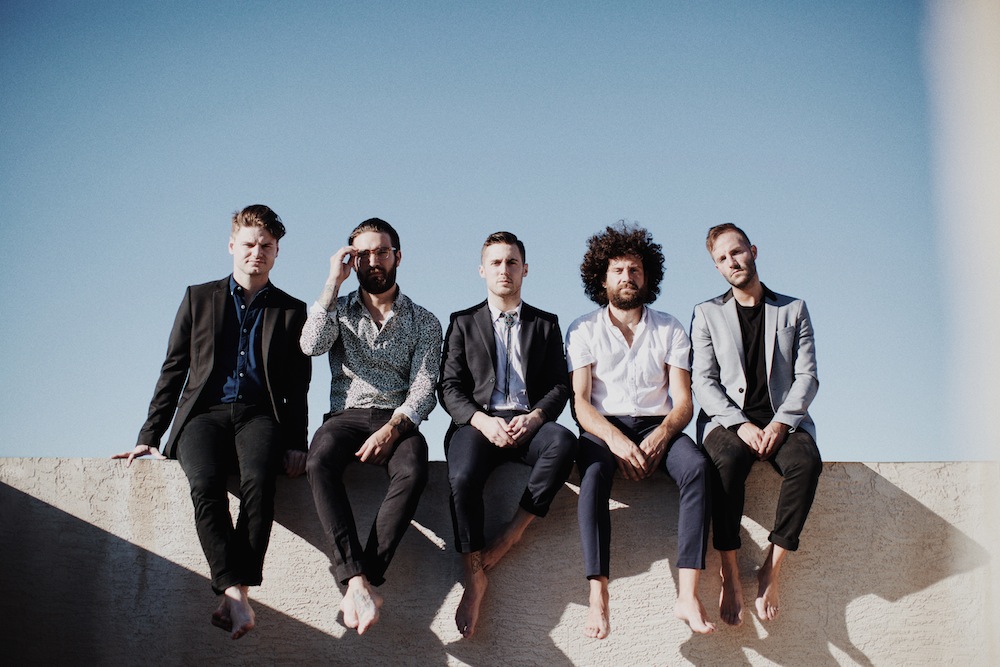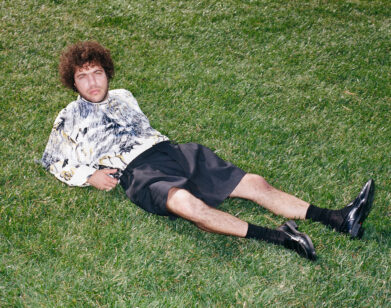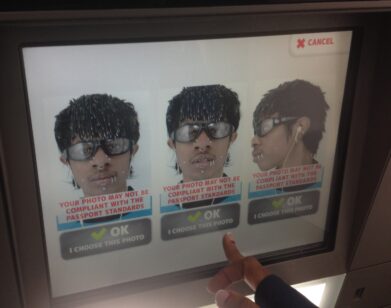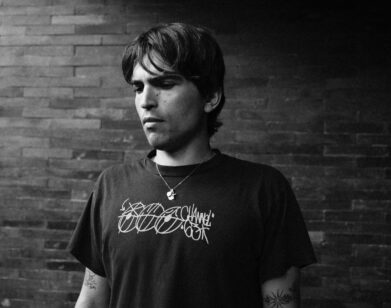Palmas’ Nostalgic Turn

ABOVE: PALMAS. PHOTO COURTESY OF SARAH KUNST.
Guitarists Matthew Young and Adam Cantiello—living at the time in Los Angeles and Philadelphia respectively—were engaged in a bicoastal exchange of ’60s surf rock records when PALMAS was born. Stirred by Brian Wilson’s falsetto and the Ventures’ guitar licks, they decided to start a band (with vocalist Kurt Cain-Walther, bassist Eric Camarota, and drummer Pat Degan) that pays homage to those musicians. PALMAS’ debut EP To The Valley (Lost Colony Music) came out in 2015 and established their musical identity: an intermingling of baroque pop and modern indie rock.
PALMAS released their latest track earlier this fall: the psychedelic single “Flowers.” The music video for this song, which premieres exclusively below, has a fittingly vintage spirit. Set on a soft, sunny day in Philadelphia to violin-infused melodies, “Flowers” is likely to rouse tender nostalgia in its viewers.
We recently spoke with Cantiello and Cain-Walther over the phone about the video’s production, their new music, and hypothetical playlist curations.
CHRISTINA CAMBRIA: What initially attracted you to the ’60s surf and soul genre?
ADAM CANTIELLO: Well, as musicians, we’re always trying to perfect the craft of playing our own instruments by learning how things are done stylistically in the music we hear. I think through that we began to really take a liking to the musical style of the artists within that genre. There’s a lot of complexity but simplicity, too, in the way that their songs are written and arranged. That’s what we all gravitated toward so it became our niche.
When we first started the band, we were writing songs and scrapping songs because we felt that they didn’t portray what we wanted to get across. We’re very selective about what we’ve been writing and the direction we’ve been taking. I think we’re pretty happy with where it’s gone—from our first release to “Flowers” and a couple of other tracks that we’ll be putting out soon.
CAMBRIA: “Flowers” seems to be somewhat of an artistic jump for you as musicians. You’re progressing into a matured sound and experimenting with some more intricate arrangements without abandoning your trademark retro revival vibe that’s present on To The Valley. “Flowers” sounds, to me, more like the Beatles circa 1967 whereas your EP sounds more like the Beach Boys circa 1964. Can you talk a bit about this subtle transition?
CANTIELLO: We had more time with this track. With the EP, we were a young band starting out. We didn’t have a lot of money so we were trying to do things as efficiently as possible, which meant going into the studio, and trying to get a lot done in a little bit of time. Whereas with these new releases, we knew what our goal was, we knew where we wanted to go, and we really took our time with arrangements and production.
KURT CAIN-WALTHER: Adam is absolutely right. When we first started, we were on an extreme budget and a time crunch. We were just excited to get music out. With these last couple of songs that we’ve been recording, it’s been more about finding exactly how we want it to sound. When we first wrote “Flowers,” it sounded much more similar to what you hear on To The Valley. But once we were finished with it, we had almost completely changed the song. The entire vibe of the song was different once we got out of the studio. That was the first time that I had ever personally gone into the studio and come out with such a different end product. So it was super intentional, the way that “Flowers” turned out. And I think it’s very much an indicator of where our heads are at right now as a band.
CAMBRIA: Listeners will obviously take away their own personal meanings, but what is the story that you intended to write within “Flowers”? What was the songwriting process like?
CAIN-WALTHER: When we wrote the song, it didn’t have any lyrics at all. We just wrote the music and we thought, “This is so pretty and kind of trippy and a little bit psychedelic.” It has that ’60s psych element to it, so we just sub-named it “Flowers” at the time. And I kind of took that away with me personally. I was like, “Flowers, flowers… I don’t want to lose that from the song.” So when I started writing lyrics, they really were generated from the name that we came up with because of the feel of the song. From that, I was like, “Well, what are flowers to me?” Flowers are these beautiful things you see around you all the time. I kind of individualized them—so there’s one flower for all my love and there’s one flower for every part of her. Each separate flower was like a different symbol, and you’re surrounded by these flowers and the flowers are surrounding her.
The song also has an element of seeing something from an outside perspective … and being happy for the people around us and being surrounded by the people around us, and how beautiful that can be.
CAMBRIA: I think the video does a nice job of visually presenting those whimsical and delicate tones found in the song’s lyrics and musicality. The colors are really quite astounding. The vibrancy in certain shots reminds me of William Eggleston‘s photography—pieces like Untitled (Girl on Grass) or Untitled (Field of Yellow and Purple Flowers). Was there a particular visual artist or filmmaker who impacted your creative decisions for the video?
CAIN-WALTHER: I personally was really inspired by ‘60s New Wave French cinema, like [Jean-Luc] Godard… The colors mostly-those saturated reds. But I think we strayed a little bit from that as the process went farther on and grew. We started working with Michael James Murray, who directed and shot the video, and he really took it into his own hands and molded it into what you see now. I saw this video called “Every Frame a Photograph.” The concept was that if you were to freeze-frame any still in a video, it would hold its own as a photograph. So, to me, that’s what I think we accomplished with the music video—or what Michael accomplished with the music video. You could freeze any shot and it would work well as a photograph.
CAMBRIA: It’s my understanding that this is the first time the band makes a physical appearance in your own music video, but you assume a very passive and secondary role by not interacting at all with the video’s main subject. What drove this decision?
CANTIELLO: I think our personality as a band, and as five individuals, drove that decision. We don’t like to be the center of attention. Also, with this video, we had the idea of the model, Grace, being unemotional and of us being physically there in the room or in the shot but not really present with her. We wanted to be in the video in some capacity but also didn’t feel the need to have Kurt sitting in the front for four minutes and singing the entire song.
CAIN-WALTHER: Yeah, the song itself doesn’t really focus on us or me. It focuses on the girl. So we thought it was appropriate that the video mirror that. But, at the same time, we kind of had to suck it up as a band and say, “Wow, we should totally be a part of the visual aspect as well as the auditory aspect of our music.”
Also, I personally don’t like being front and center in pictures for the band. Some people think that that’s important for a lead singer, but I consider PALMAS to be a unit. I think that came across in the video as well. We are all a part of this.
CAMBRIA: Kurt, when I was talking to you after your show at Rockwood the other week, you told me to go home and listen to “Let’s Hang On” by Frankie Valli and the Four Seasons. I was very pleased by the suggestion, but not at all surprised because I remember thinking of Frankie Valli as I was watching you play. If you two were to curate “favorites” playlists for your friends, would listeners be surprised by what they’d find inside? Or is the sound of your music as a band pretty indicative of your taste as a consumer?
CANTIELLO: I think there’s a varied mix of music that I take in and listen to. There probably is a greater amount of ’60s music just because of how much, as an individual and as a band, we immerse ourselves in that type of music. And I think that it’s great to be influenced like that, but I also think that what makes an artist unique is if he or she is able to incorporate elements from other types of genres or different things that might not be so predictable. So I think if I were to make a playlist, you would definitely see a lot of ’60s, like Margo Guryan, and then some modern stuff like Twin Peaks or the Shivas—bands that we enjoy and look up to as well. But you might also catch a Santigold song in one of my playlists. [laughs] So don’t just assume that it’s going to be all ’60s because you might catch a curveball!
CAIN-WALTHER: I don’t think I can answer that question any better. I mean, Adam totally summed it up. I think that’s why PALMAS has such a unique and collective sound, because we all feel that way. We all have different tastes in music and I think that comes through. What makes PALMAS’ music is all of our interests, not just one person’s.
CAMBRIA: We’re obviously living in a pretty different musical climate than that of the era that PALMAS primarily draws inspiration from. What is it about music production in the ’60s that you’re most nostalgic for?
CAIN-WALTHER: It’s tough to say because, in the age that we live in right now, there are so many different types of music. So you can’t really say, “Oh, I wish people still played this way or I wish people still did this,” because if you really search, there are people doing that. But I do think that popular music is a bit watered down now. I watched an interview with Snoop Dogg recently and I think he said it best. He said there was a time when you would get called out for copying another artist. But now everything on popular radio sounds the same; it’s like someone wrote a formula and if you just write a song that fits in that formula, and you work with the right producer then, boom, you have a #1 hit single. And that’s my personal pet peeve about the way the music industry is right now. There was a time when something would come out that was just so experimental that it would blow you away. That’s what I’m nostalgic for. If you write genuine, heartfelt, thought-provoking music, I think you should have a chance to have that heard on a massive level. But I think that is happening. It’s starting to happen slowly. We’re having a small revolution in music because I think people are tired of hearing the same old thing.
CANTIELLO: Yeah, the qualm that I have with the music industry today is the idea that copy and pasting is okay. It’s the new standard. It loops back to what Kurt said—it’s like this formula and I think that’s resulted in a loss of artistic integrity in some ways. And everyone has access to laptops and GarageBand so anyone can be a producer now. Whereas if you go back and… Even look at Snoop Dogg to touch back on what Kurt was saying, when N.W.A. was starting out, they were sitting down and making beats and sampling old records, and I feel like that process is happening less and less.
CAIN-WALTHER: Yeah, we’re secret hip-hop artists. [all laugh] You guys didn’t know that.
CAMBRIA: In a way, the fact that anyone can be a producer or a marketer of his or her own work could also be seen as a solution to the “radio formula” issue that you’re talking about. Anybody’s music can get out there even if it doesn’t necessarily land in the right corporate hands. So, like Kurt said, if you know where to look you can probably find even more experimentation in music now than ever before.
CAIN-WALTHER: Totally! And that’s really with anything… Not just music, but art and photography and film—anything. There’s so much collectively growing out there. It’s all about trying to better yourself in what you create and trying to find better things in the world.
FOR MORE ON PALMAS, VISIT THEIR FACEBOOK.






